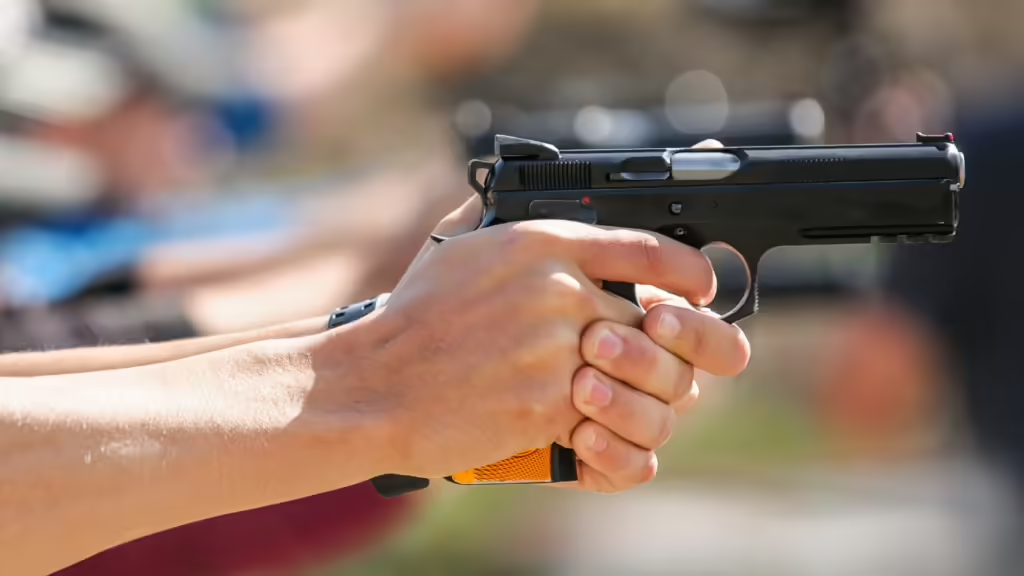
Whether you’re new to shooting or a seasoned marksman, mastering the proper handgun grip is essential to achieving the precision, consistency, and control you want. A solid grip not only enhances your ability to aim accurately but also helps manage recoil, speeds up your follow-up shots, and promotes safe handling. In this guide, we’ll break down the core elements of a solid handgun grip, discuss techniques to stabilize your aim, and explore ways to manage recoil effectively. Proper Handgun Grip for Accuracy is a question always on the mind of new shooters, here is our deep dive on how best to get on target more consistantly.
The Importance of a Proper Handgun Grip
A proper grip forms the basis of your control over the firearm, significantly affecting accuracy and consistency. A firm, balanced grip is essential for stabilizing the handgun, minimizing movement, and ensuring that each shot lands where you intend. Additionally, good grip technique enhances recoil control, allowing for quicker, more accurate follow-up shots. For competitive shooters and those focused on defensive tactics, a reliable grip is key to faster responses and improved confidence.
Core Elements of a Proper Handgun Grip
For effective shooting, understanding the core elements of a handgun grip is crucial. Proper hand placement, pressure distribution, and finger alignment all contribute to a stable, comfortable hold that facilitates precise shooting.
Thumb Webbing Placement
One of the most essential aspects of grip control is the placement of the webbing between your thumb and index finger on the dominant hand. For optimal stability, place the webbing as high as possible on the beavertail or backstrap of the handgun. This high grip helps control the muzzle flip (the upward motion of the gun after firing), giving you more natural control over recoil and enabling faster recovery between shots.
Creating a Vise with Both Hands
Imagine your two hands functioning as a vise around the handgun. While your dominant hand takes the lead in aiming, your support hand applies additional stabilization. By applying even, inward pressure with both hands—especially focusing on the first knuckle of each pointer finger—you can create a balanced, steady hold that minimizes side-to-side movement, keeping the handgun aligned with your target.

Finger Placement for Stability and Comfort
A secure yet relaxed finger placement helps avoid excessive shaking or tension, both of which can hinder aim and control. Allow your fingers to rest naturally along the grip, ensuring a secure hold without squeezing too tightly. Over-gripping can lead to tension in your hands, causing them to shake and impacting your accuracy. A natural grip promotes stability, helping you maintain focus and control with each shot.
Avoiding Excessive Pressure
Squeezing the handgun too tightly not only causes fatigue but also introduces instability. Instead, find a grip that feels firm without causing tension, allowing for smooth, controlled shooting. This relaxed but secure grip lets you remain focused on your target while maintaining control over the handgun.
Enhancing Control with a Gas Pedal
A “gas pedal” is a ledge or small protrusion on some handgun models designed to provide additional leverage. When you place your support hand’s thumb on the gas pedal, you gain added downward pressure, which helps keep the muzzle in check and minimizes upward movement. For shooters focused on rapid-fire or competitive shooting, this added control is invaluable in managing recoil and maintaining quick, accurate follow-up shots.
Using a Gas Pedal for Competitive Edge
For competitive shooters or anyone looking to optimize control and speed, a gas pedal offers a valuable advantage. By stabilizing your aim with downward pressure, you’re able to maintain a clear line of sight, even in high-pressure, rapid-fire situations. Incorporating a gas pedal into your grip technique can make a significant difference, especially when seconds matter.
Establishing a Strong Grip from the Holster Draw
Consistency in your grip begins the moment you draw from the holster. Forming a solid grip as you draw is essential because adjusting your grip mid-action can waste valuable time and reduce accuracy. Ensure that as soon as your hand touches the gun, it naturally assumes a secure and correct position, eliminating the need for adjustments mid-shot.
Building Muscle Memory for Consistent Draws
Practicing your holster draw with a focus on grip consistency builds muscle memory, making it easier to adopt the correct hold in live situations. Dry-firing exercises and timed holster drills are excellent ways to develop this skill. Begin slowly, focusing on accuracy, and gradually increase your speed, always maintaining your initial grip.
Practical Drills for Improving Handgun Grip
Consistent practice is essential for developing a reliable grip. Some effective drills include:
- Dry Firing: Practice gripping and aiming your unloaded handgun, focusing on keeping your hold stable and natural.
- Timed Draw Drills: Start with slow, precise draws from the holster, gradually increasing speed while keeping your grip intact.
- Follow-Up Shot Practice: Focus on shooting multiple shots in succession, ensuring that your grip remains consistent to improve accuracy.
These exercises build the muscle memory necessary for reliable grip technique, ensuring that you maintain control and accuracy under any circumstances.

Common Mistakes to Avoid in Handgun Grip
Even experienced shooters occasionally make mistakes in their grip, which can negatively impact accuracy. Here are a few common issues to watch for:
- Over-gripping: Squeezing the gun too hard causes muscle tension and reduces control. Find a balance that allows for a secure yet relaxed hold.
- Incorrect Finger Placement: Misalignment of fingers can cause discomfort and affect stability. Ensure fingers fall naturally along the grip.
- Adjusting Grip Mid-Shoot: Refrain from adjusting your grip between shots. Develop a consistent starting position that remains stable throughout.
Building Confidence Through Grip Mastery
Mastering the proper handgun grip takes time and practice but can profoundly impact your shooting experience. With a secure grip, you’ll not only shoot with more confidence but also have greater control over each shot’s placement. Over time, as you continue refining your grip technique, you’ll notice improvements in both your speed and accuracy.
Conclusion: Building Accuracy and Control with a Proper Handgun Grip
Learning and practicing a proper handgun grip enhances every aspect of shooting, from aim to recoil management and overall control. By placing the web of your thumb high on the backstrap, applying focused inward pressure, utilizing a gas pedal for stability, and establishing a consistent grip from the draw, you’ll set yourself up for success in any shooting environment. Consistent, dedicated practice of these techniques will help you achieve greater accuracy, faster follow-up shots, and a more controlled shooting experience.
So next time you’re at the range, focus on fine-tuning your grip technique, and watch as your accuracy and control transform. Let’s lock down that perfect grip and take your shooting to the next level!

FAQs
What is the best handgun grip technique for beginners?
Beginners should focus on placing the web of their thumb high on the backstrap, creating even inward pressure with both hands, and allowing fingers to fall naturally along the grip. This creates stability and minimizes recoil, making it easier to aim accurately.
How does a proper handgun grip help with recoil?
A proper grip helps control the handgun’s movement, especially during recoil. By applying high thumb webbing placement and even pressure, shooters can minimize muzzle flip and recover quickly for follow-up shots.
Is it necessary to use a gas pedal on my handgun?
While not essential, a gas pedal can provide added stability and control, especially for rapid-fire or competitive shooting. The additional downward pressure helps manage muzzle rise, allowing for faster, more accurate follow-up shots.
Can I adjust my grip mid-shoot if it feels uncomfortable?
It’s best to establish a consistent grip from the start. Adjusting mid-shoot can disrupt your accuracy and reduce control. Practice building a comfortable, stable grip from the beginning to minimize the need for mid-shot adjustments.
How can I practice handgun grip at home?
Dry firing with an unloaded handgun is an effective way to practice grip. Focus on building a stable hold and work on maintaining consistency with each aim and pretend shot. Holster drills and drawing practice are also helpful.
What should I do if my hands shake while gripping the handgun?
If you experience shaking, it may indicate you’re gripping too tightly. Try loosening your grip slightly, focusing on a balanced hold rather than a tense squeeze. Relaxed muscles will reduce shaking and help you aim more accurately.












